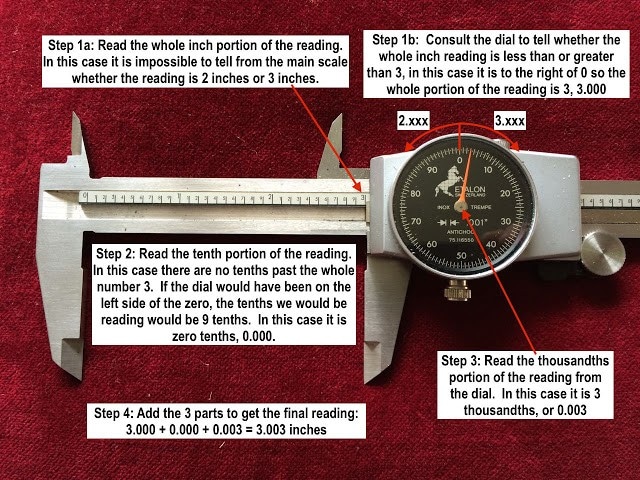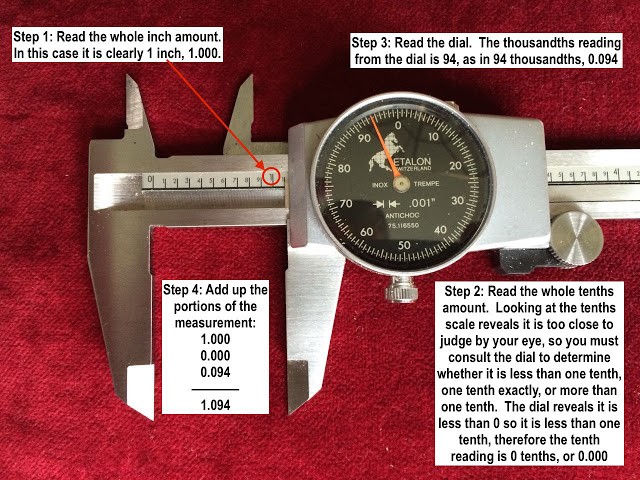I love my Brown & Sharpe caliper. If you’ve used a cheap caliper you’ll know how frustrating it is to think you machined a part to specification and then learn that your caliper is not calibrated. I was having to calibrate my other caliper all the time. This Brown and Sharpe caliper goes back to zero EVERY TIME. If it does not go back to zero then most likely you have a speck of something on the jaws that it is measuring, so wipe them off. If you must do much measuring with a caliper it is worth buying a nice reliable one and I really recommend these. Get one with a thumb wheel too, that’s a must.
An inch caliper allows you to make precise measurements to a thousandth (.001) of an inch. You read the whole “inch” amount on the main scale, the whole tenth (.01) amount on the main scale, and then determine the thousandths portion of the measurement on the dial.
Hardware:
I love my Brown & Sharpe caliper. If you’ve used a cheap caliper you’ll know how frustrating it is to think you machined a part to specification and then learn that your caliper is not calibrated. I was having to calibrate my other caliper all the time. This Brown and Sharpe caliper goes back to zero EVERY TIME. If it does not go back to zero then most likely you have a speck of something on the jaws that it is measuring, so wipe them off. If you must do much measuring with a caliper it is worth buying a nice reliable one and I really recommend these. Get one with a thumb wheel too, that’s a must.
An inch caliper allows you to make precise measurements to a thousandth (.001) of an inch. You read the whole “inch” amount on the main scale, the whole tenth (.01) amount on the main scale, and then determine the thousandths portion of the measurement on the dial.
 |
| The different markings of a caliper (click on the image to see a larger version) |
What makes it tricky to accurately read a caliper is when the measurement approaches a whole measurement but is a few thousandths under or a few thousandths over. It is not possible to discern with the naked eye the difference between .998 and 1.000 and 1.002 on the main scale–you must consult the dial to determine whether the measurement is less than an inch (.99x), an inch (1.000), or slightly over an inch (1.00x). You also need to make sure to keep track of your decimal places when adding the thousandths from the dial measurement to the whole and tenth portion.
Just to review I’d like to go over the place values of decimals, since I’m going to refer to them below:

How to Read a Dial Caliper
Step 1: Read the whole inch (x.000) portion of the measurement.
What you are looking for is how many whole inches the measurement contains. The whole inch portion of the following reading is :
 |
| The reading is 2 whole inches and then a portion of an inch, which we’ll determine in the next steps |
At this point we know our measurement is at least 2.000.
Step 2: Read the whole tenth (0.x00) portion of the measurement.
Inches on the main scale are broken into ten parts, tenths. Count how many whole tenths past the whole inch amount you determined in step 1:
 |
| Reading the tenths portion of the measurement–4 tenths (click on the image for a larger version) |
We now add this 4 tenths (0.400) to the whole number inch reading (2.000) from step 1. When you add decimals you must line up the decimal places. At this point our measurement is: 2.000 + 0.400 = 2.400.
Step 3: Read the thousandths (0.0xx) portion of the measurement.
The dial on the caliper is broken up into 100 increments. The dial rotates around one time for each tenth. Read the 2-digit thousandths reading from the dial. If the reading is less than 10 then think of it as 09, 08, 07, 06, 05, 04, 03, 02, or 01. The reading in our current example is 25 thousandths (.025):
 |
| The dial is indicating 25 thousandths (.025) |
Now we must add our thousandths reading from the dial to the sum of the whole inches and tenths from step 2: 2.400 + 0.025 = 2.425. The measurement this caliper is indicating is 2.425 inches. That’s how you read a caliper.
Caliper Reading Examples:
The best way to learn how to read a caliper is by looking at example measurements (and then practicing). I’ll give a bunch of example measurements with all the steps written out of how to read them…
Example 1:
 |
| Caliper Reading Example 1: 2.560 inches |
Step 1: Read the whole inches. Look at how many whole inches show on the main scale. You can clearly see that this reading is going to be 2 inches and a portion of an inch. So the answer to the first step is 2.000.
Step 2: Read the whole tenths. We can see that the reading is clearly past the 5 on the tenth scale. So the tenth reading is 0.500. Adding that to step 1 we have 2.000 + 0.500 = 2.500.
Step 3: Read the dial to get the thousandths. The dial is pointing at 60, 60 thousandths or 0.060. To get the final solution add the thousandths to the answer from step two: 2.500 + 0.060 = 2.560 inches.
Example 2:
 |
| Caliper Reading Example 2: 0.681 inches |
Step 1: Read the whole inches. In this case the reading is under 1 inch, so the whole inch reading is 0.000.
Step 2: Read the whole tenths. The tenth reading is clearly past the 6 line so the tenth reading portion of the measurement is 0.600. Add that to the whole inch portion: 0.000 + 0.600 = 0.600.
Step 3: Read the dial to get the thousandths. The dial is pointing at 81, 81 thousandths or 0.081. To get the final solution add the thousandths to the answer from step two: 0.600 + 0.081 = 0.681 inches.
Example 3:
 |
| Caliper Reading Example 3: 3.003 inches |
Step 1: Read the whole inches. When you look at this caliper above your first look might be to say it is right on 3 but it is impossible to tell by looking at the main scale whether the reading is slightly below 3, and therefore the reading will be 2.xxx right on 3, or 3.000, or above 3 at 3.xxx. You must consult the dial to see if it is above or below 3.000. In this case, consulting the dial tells you that the reading is to the right of 3.000. Therefore the whole number, whole inch, reading will be 3.000.
Step 2: Read the whole tenths. Because the reading is just slightly above 3.000, there are clearly no whole tenths to report in this step. The tenths portion is 0 tenths or 0.000. Adding the amount from step one to this step leaves us: 3.000 + 0.000 = 3.000
Step 3: Read the thousandths from the dial. The dial reads 3 thousandths. You would write this 0.003. Add this to the answer from step 2: 3.000 + 0.003 = 3.003 and the final answer is 3.003 inches.
Example 4:
 |
| Caliper Reading Example 4: 0.999 inches |
Step 1: Read the whole inches. Again here you cannot determine whether the reading is below 1 inch, on 1 inch or above it by only looking at the scale, you must consult the thousandths dial. By looking at the dial you can see that the needle is not yet at 0, or to the left of zero, so the reading is less than 1. The whole inch portion of this reading is 0.000.
Step 2: Read the whole tenths. The whole tenth reading is 9, or 9 tenths, 0.900. You can add this to the zero from step 1 and we still have 0.900.
Step 3: Read the thousandths from the dial. The dial reads 99 thousandths, or 0.099. Add this to the answer from step 2: 0.900 + 0.099 = 0.999 inches.
Example 5:
 |
| Caliper Reading Example 5: 1.094 inches |
Step 1: Read the whole inches. In this case it is clear that the whole inches reading is 1 inch, or 1.000.
Step 2: Read the whole tenths. It is too close to tell by the main scale whether it is less than 1 tenth, on 1 tenth, or more than one tenth. You must look at the dial to see if the needle is approaching the 0, on the 0 or past the zero to tell whether it is less than 1 tenth, a tenth exactly, or more than one tenth respectively. In this case the needle hasn’t reached 0 yet so the measurement is less than 1 tenth. The reading for this step is 0 tenths, or 0.000
Step 3: Read the thousandths from the dial. The reading on this dial is 94 thousandths, or 0.094. (that last dot is my period in the sentence, not the decimal point)
Step 4: Add up the portions to get the measurement. 1.000 + 0.000 + 0.094 = 1.094 inches.
Note: Sometimes I add the portions up as I go and sometimes I add them up at the end. Once you get this stuff down you’ll do it in your head as you go.
Amazon Associate Disclosure: As an Amazon Associate I earn from qualifying purchases. This means if you click on an affiliate link and purchase the item, I will receive an affiliate commission. The price of the item is the same whether it is an affiliate link or not. Regardless, I only recommend products or services I believe will add value to Share Your Repair readers. By using the affiliate links, you are helping support Share Your Repair, and I genuinely appreciate your support.


